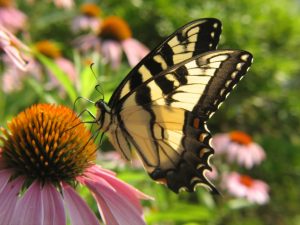Excited to get your spring plants into the ground? This year try planting a pollinator garden using native plants. You’ve probably heard that pollinators (mostly insects) are responsible for roughly 35 percent of crop production in the U.S., and that they‘re facing unprecedented threats from climate change, habitat loss, and pesticide use. Even if you only have a small yard or porch, you can help bolster the local pollinator population by choosing plants that attract bees, butterflies, and birds.
How does pollination work? Why are bees threatened? How does this affect agriculture? Pollinator Friendly Gardening makes the essential concepts easy to understand, even giving tips on pro-pollinator public advocacy.
When I first noticed a beautifully patterned caterpillar on a plant in my window-box, I thought it must be a monarch butterfly larva, but further research revealed that it was a black swallowtail. Gardening for Butterflies will help you identify butterflies and support them in all life stages.
Did you know there are over 4000 bee species in North America? And that the honey-bee, which originated in Europe, is not a native species? The Bee-friendly Garden and 100 Plants to Feed the Bees offer tips on helping rebuild bee populations, with descriptions of common bee species, plant guides, and ideas for controlling common garden pests without pesticides.
For attracting birds, Birdscaping in the Midwest and Gardening for the Birds provide strategies beyond the bird-feeder. In fact, using native plants to bring birds to your yard instead of bird-feeders might be less disruptive to the local ecology, and online debates on the pros and cons are common.
Happy spring, see you in the garden!




Add a comment to: Create a Buzz: Pollinator Gardening